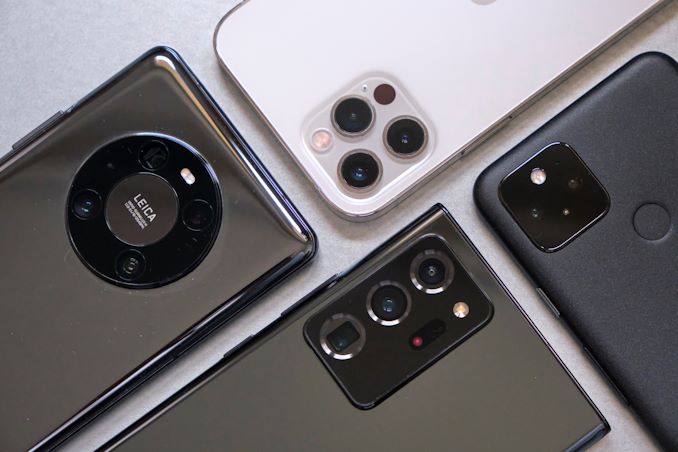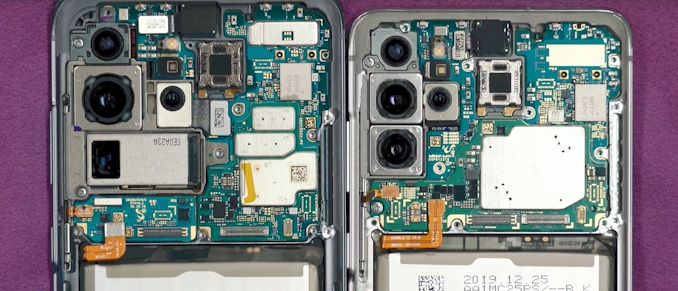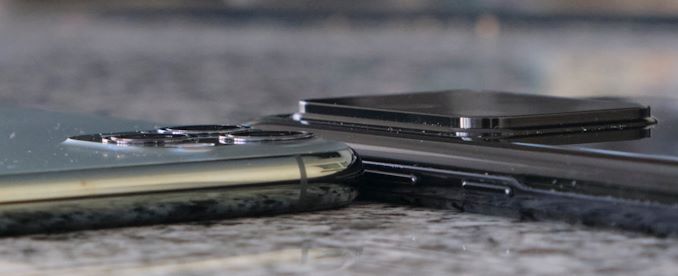AnandTech Year In Review 2020: Flagship Mobile
by Andrei Frumusanu on December 28, 2020 8:00 AM EST- Posted in
- Mobile
- Apple
- Samsung
- Smartphones
- Huawei
- SoCs
- OnePlus
- Year In Review

We’re a few days away from completing the 2020 calendar year, and it’s been a quite a hectic year for everybody. In times of troubles, the smartphone industry had been under a two-prong attack from both an economic stand-point as well as the from a product maturity standpoint – trying hard to innovate with new features to convince users to upgrade their previous generation devices. This year, we’ve seen several new industry trends make breakthrough advances in terms of technology in smartphones, beyond the obvious elephant in the room, by which 2020 will be remembered by: Big camera sensors, 120Hz displays, several large SoC moves, 5G, and several other vendor product choices.
Big Sensors go Mainstream
Although a subjective opinion, what I view as one of the most important developments in 2020 mobile devices has been the widespread adoption of larger camera sensors. While in years past, Huawei had been the notable exception to the rule in terms of adopting larger camera sensors in their smartphones, this year, we’ve seen almost everybody make the transition to larger formats – either 1/1.78” sensors or even the new humongous 1/1.33” beasts in some flagships.

Galaxy S20 Ultra & Galaxy S20+
Bigger sensors most of the time means that vendors are able to use bigger pixels – which in turn results in better dynamic range capability and better low light captures. This year we’ve seen many flagships at least adopt a 1/1.78” sensor which is notably larger than previous generation 1/2.3” or 1/2.5” units – resulting in 12MP 1.8µm pitch units like on the new S20 series and some other vendors such as Sony.
Other vendors have opted to go even bigger – ranging from 1/1.3” to 1/1.4” sensors. The most notable and talked about has been Samsung’s new 108MP units in the S20 Ultra and Note20 Ultra series. Although the high-pixel count sensors deployed on these devices have questionable benefits in their native resolution, the ability to bin 3x3 pixels down to an 12MP image means we’re looking at effective light gathering capabilities similar to that of a 2.4µm pixel pitch sensor, something well beyond other current sensors on the mobile market.
We’ve seen variations of these huge sensors – Xiaomi also uses a 108MP native unit but bins down by 2x2 to a 27MP capture mode in general use-cases, while OnePlus had opted for a slightly smaller 1/1.4” sensor in the OnePlus 8 Pro with a 48MP native resolution, binning down to 12MP.
The big caveat with these big sensors is their optics systems – many times the plastic lenses can’t keep up with the resolution of the sensors, partly negating some of their characteristics, making much of the 108MP contenders relatively gimmicky in real-world scenarios.

iPhone 11 Pro vs Galaxy S20 Ultra
The other big issue with larger sensor sizes is that they require a larger z-height of the camera module, which means larger camera bumps. And oh boy, we did get some really funky looking camera bumps in this year’s devices, such as the massive design element on the S20 and Note Ultras.
Related Reading:
- Xiaomi’s Mi Note 10 Family: World’s First Smartphones with 108 MP Penta Camera Array
- Samsung Unveils ISOCELL Bright HMX 108 MP Sensor for Smartphones
- The Samsung Galaxy S20+, S20 Ultra Exynos & Snapdragon Review: Megalomania Devices
- The OnePlus 8, OnePlus 8 Pro Review: Becoming The Flagship
- Xiaomi Globally Launches Mi 10, Mi 10 Pro; Snapdragon 865 & 108MP Cameras
- The Xiaomi Mi 10 Pro Review - A Solid Overall Value
- Samsung Announces New 50MP Dual-Pixel and Quad-Bayer ISOCELL Sensor
120Hz, An Almost Must
Another big development this year has been the mainstream adoption of high refresh rate display panels. While in 2019 90 or 120Hz displays were exotic or reserved for special gaming-oriented phones, in 2020 it could be said that it was a checkmark feature for almost every vendor, essentially eliminating 60Hz from almost all new product releases bar the mid-range or low-end.
Though 120 and 90Hz displays this year certainly have augmented the fluidity and user experience of flagship devices, only the Note20 Ultra was the one device which was able to adopt this with relatively few drawbacks, thanks to its new polycrystalline and oxide panel technology. For the rest of the market, 120Hz came with a relatively larger battery impact, meaning the new fluidity came with a device longevity compromise.
For 2021, I see more vendors adopt the new 120Hz feature in a more optimised manner that improves upon the battery consumption, maturing the technology to a point where it becomes a no-brainer to have it enabled by default.
Related Reading:
- The Samsung Galaxy S20+, S20 Ultra Exynos & Snapdragon Review: Megalomania Devices
- The OnePlus 8, OnePlus 8 Pro Review: Becoming The Flagship
- The ASUS ROG Phone III Review: A 144Hz 6000mAh Beast With Caveats
- Samsung's Note20 Ultra Variable Refresh Rate Display Explained
Exynos Core Death (& Revival?)
Continuing with our takes on key hardware component changes in 2020, one large move has been Samsung’s abandonment of their custom CPU cores in their Exynos chipsets. Struggling with power efficiency and performance competitiveness for several years now, Samsung LSI finally cut the cord on their custom CPU core design project and team, opting to instead fully rely on Arm’s future Cortex CPU IP for next-generation Exynos SoCs.
We had been covering Samsung’s cores in detail for several years now, and it’s unfortunate to say that the project’s cancellation is likely the best-case scenario for future Exynos SoCs, dropping one of the chip’s most negative aspects – and in turn likely result in significantly better designs in 2021, hopefully eliminating some of the performance and power efficiency differences between Snapdragon and Exynos Galaxy phones.
Related Reading:
- Samsung Announces Exynos 990: 7nm EUV, M5, G77, LPDDR5 Flagship SoC alongside Exynos 5123 5G Modem
- The Samsung Galaxy S20+, S20 Ultra Exynos & Snapdragon Review: Megalomania Devices
- ISCA 2020: Evolution of the Samsung Exynos CPU Microarchitecture
- Samsung Announces Exynos 1080 - 5nm Premium-Range SoC with A78 Cores
- Samsung Teases CES Announcement For Next Exynos SoC
MediaTek Dimensity Resurgence
2020 marked MediaTek’s re-entry into the high-end SoC market, introducing the new Dimensity 1000 SoC. Although the new design was off to an extremely slow start with very few design wins in the first half of the year, the company’s efforts in the mid-range Dimensity series has results in a large amount of design wins, and according to Counterpoint Research, allowed the company to actually position itself as the #1 SoC vendors in Q3 2020, taking market share from the likes of Qualcomm.
We had reviewed the Dimensity 1000 inside of the OPPO Reno3 5G and found it to be an excellent SoC in terms of performance and efficiency – what’s really lacking though is a more prestigious high-volume design win that has more visibility. Hopefully MediaTek manages to achieve such a design in 2021.
Related Reading:
- MediaTek Announces Dimensity 1000 SoC: Back To The High-End With 5G
- CES 2020: MediaTek Announces New Dimensity 800 Mid-Range 5G SoC
- MediaTek Announces Dimensity 1000+ SoC
- MediaTek Announces Dimensity 820 Mid-Range SoC With More Performance
- OPPO's Reno3 5G vs Reno3 Pro vs Reno3 Pro 5G: Why Don't We See More MediaTek Dimensity 1000 Phones?
5G for Most
While 5G has been a premium “the new thing” feature in some 2019 devices, it can be said that it’s really in 2020 where the new cellular communication standard has really been adopted as a mainstream technology in new smartphone products. Almost every new Android flagship device has had 5G as a selling point in 2020, and with Apple’s release of 5G-only iPhone 12 series, we can pretty much say we’ve made a turning point between 4G and 5G.
Although cellular networks in many countries are still in deployment and it’ll probably be a few years before 5G becomes ubiquitous for everybody, buying a 4G device today is no longer the best long-term investment unless you’re really looking at low-end devices. 5G also has trickled down to the premium and mid-range thanks to the likes of SoCs such as the Snapdragon 765 – with 2021 projected as being the year where we’ll also see the $250 device market also adopt 5G connectivity.












56 Comments
View All Comments
s.yu - Tuesday, December 29, 2020 - link
lmao?Sub-6 increases spectrum by eating into the previous 2G spectrum(which provides a low bandwidth with high penetration), otherwise it uses the nearly the exact same spectrum as LTE, at nearly the exact same bandwidthAndrei Frumusanu - Wednesday, December 30, 2020 - link
No. Most of the world is getting a new large chunk of never used before spectrum in the 3.5GHz range for sub-6. I'm aware the US frequencies are a fragmented shit-show, and probably the root reason why mmWave is marketed more. The rest of the world are getting gigabit speeds on sub-6.s.yu - Saturday, January 2, 2021 - link
Ok, I'm not aware of all the world's bands but it's been tested that on identical bands 5G is generally no faster yet less power efficient than LTE(not to mention new patent royalties). There's no technical barrier to LTE using a wider range of sub-6 bands in the first place, LTE could also reach gigabit speeds with CA. It's only with the most recent mmWave tests(a month or so ago?) that 5G has actually reached speeds unobtainable with LTE. Regarding consumer experience, the world's fastest LTE, SK's, is nearly the same speed as SK's 5G, while being more stable.techconc - Wednesday, December 30, 2020 - link
In theory, I agree with you Andrei. However, in practice, FunBunny2 is correct. In most cases, Sub-6 5G is no better than the LTE I previously had. The only advantage so far has been from a marketing perspective. Maybe that's a different story on other carriers, but on AT&T there is no real difference at this point. We've all been told how important 5G is, yet in practice it's pretty much the same. mmWave 5G is the only version where people would be able to perceive a difference and as others have mentioned that's pretty much non-existent for most.Andrei Frumusanu - Wednesday, December 30, 2020 - link
Again, that's an US issue. The rest of the world is getting large amounts of new spectrum in sub-6 with large speed increases.StevoLincolnite - Monday, December 28, 2020 - link
Ironically... My Samsung Galaxy Note20 Ultra 5G gets about 84Mbps on 4G and around 110Mbps on 5G.Considering data caps are counted in only "10's" of Gigabytes here, I don't think the difference in bandwidth is even worth mentioning at this stage considering you can blow your entire cap in just a few minuets even on 4G.
To be fair though... Australia's 4G network easily outclasses most other Nations anyway, same went for our 3G networks, not just in terms of bandwidth but how extensive the networks are in terms of land coverage.
s.yu - Tuesday, December 29, 2020 - link
Your data must be very expensive with such high speeds serving such few people across such a wide land area. I don't envy you with my ~$3/mo plan with unlimited dedicated data toward a few commonly used apps and otherwise 1GB included. It's usually enough and excess data is cheap too.Ptosio - Monday, December 28, 2020 - link
The only trend I care for in 2021: mini versions of flagships.Current phones are already well above "good enough": but what for, if I cannot hold them in my hand?
pandemonium - Monday, December 28, 2020 - link
Big sensor section needs mention of the 1/1.2" in the 808 Pureview. It still takes pretty great photos, even being 8 years old now.And they say Nokia doesn't invent any more...they were ahead of the curve on that one by at least a decade. :P
s.yu - Tuesday, December 29, 2020 - link
Sadly the Nokia responsible for the 808 is not the current Nokia(HMD), with Microsoft in between.